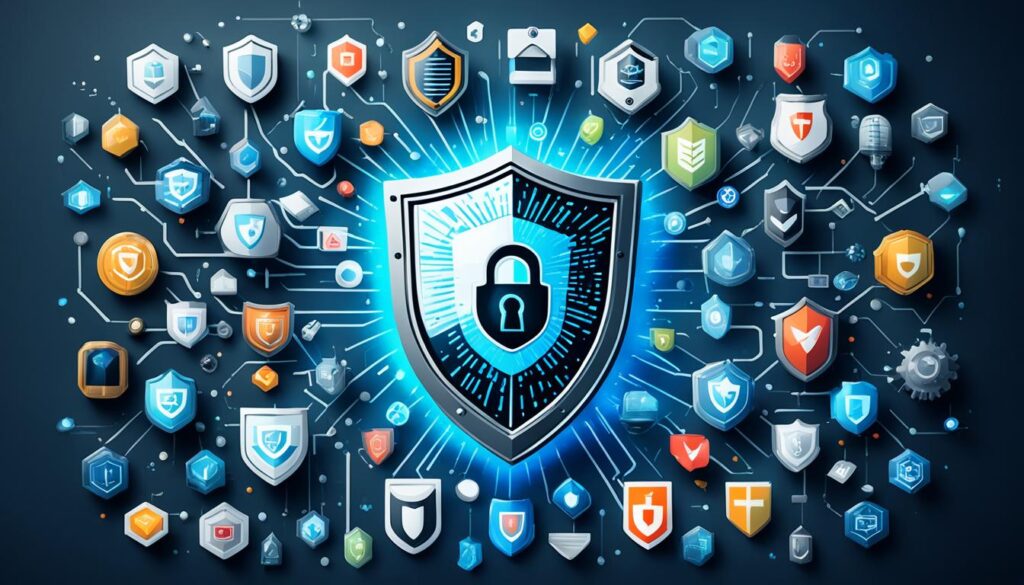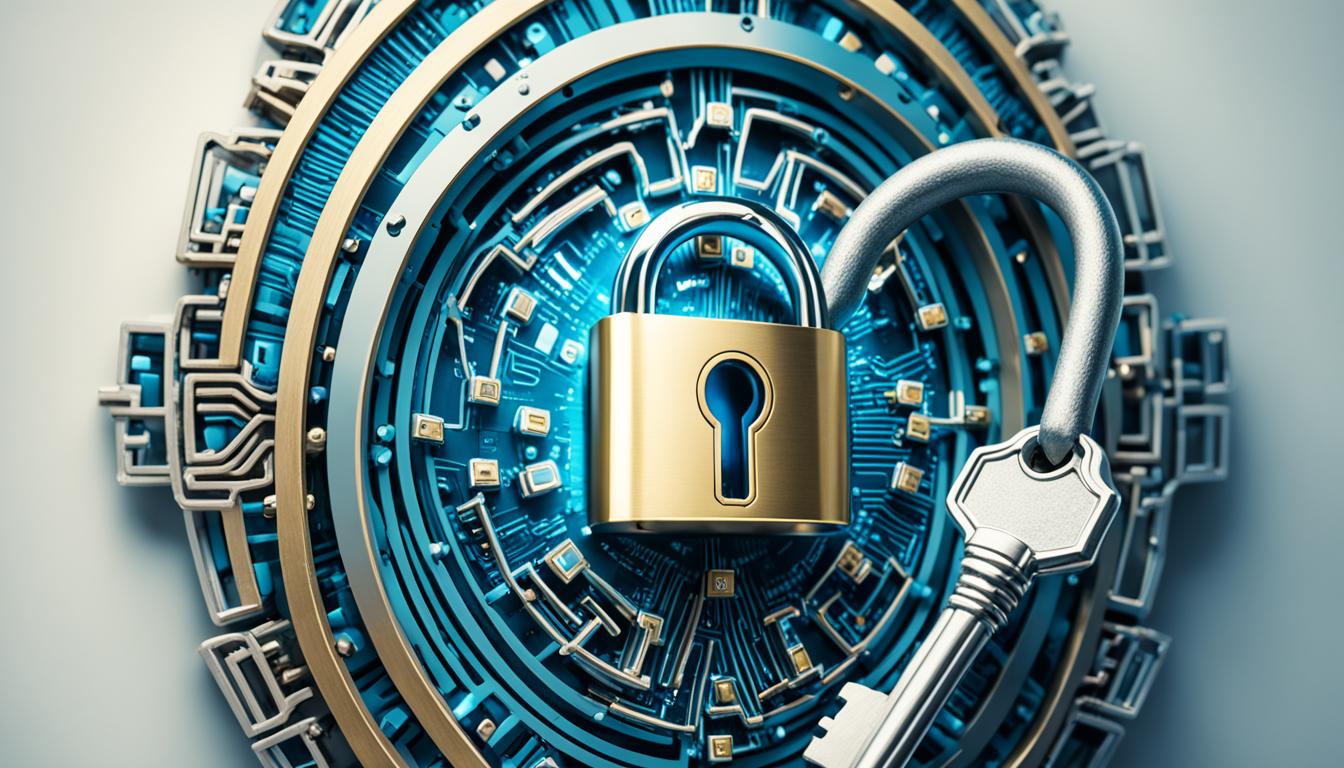Cyber attacks are increasing, putting both people and companies at risk. They try to shut down computers, steal important data, or cause more harm by using hacked systems. The attackers use malware, phishing, and ransomware to target those who are not fully protected.
To defend your digital world, there are things you can do. These steps will help keep you and your information safe from cyber threats.
Be careful with links and downloads that seem off. Hackers often hide harmful software in these to get into your system. Always check if a link is real before you click on it to avoid risk.
Using strong passwords is another important step. Weak passwords are easy for hackers to break. Make sure your passwords include numbers, symbols, and capital letters. Also, don’t use the same password for different accounts.
Making use of multi-factor authentication adds more security. Even if someone gets your password, this extra step keeps them out.
Watching out for secure internet sites is key. Look for the “HTTPS” in website addresses and avoid those that lack proper security. This protects your data when you shop or share information online.
Don’t forget to keep your anti-virus software up to date. This way, you’re shielded against the newest threats. Updating regularly seals off openings hackers might target.
Stay alert and report anything odd to your IT team right away. Quick action helps stop breaches early, which is vital for keeping your systems secure.
For more help on fighting cyber threats and staying secure, check out CISA.Gov. They provide tips on avoiding ransomware, dealing with malware, and making your Wi-Fi network safe.
Key Takeaways:
- Remain cautious of suspicious links and downloads to avoid falling victim to cyber attacks.
- Create strong and unique passwords for each online account, incorporating numbers, special characters, and capital letters.
- Enable multi-factor authentication to add an extra layer of security to your online accounts.
- Access websites that use “HTTPS” for secure internet communications and transactions.
- Regularly update your anti-virus software to protect against emerging cyber threats.
What is a Cyber Attack?
A cyber attack is when cybercriminals try to harm computer systems. They may disable computers, steal important information, or use these systems for more attacks. The damage can affect people, companies, and governments. Knowing about different kinds of cyber attacks helps us protect against them.
Common Methods of Cyber Attacks
Malware: Malware is a top method used by cybercriminals. It’s a harmful software that enters systems to cause damage. It often comes through email attachments, bad websites, or risky downloads. Hackers can use it to enter systems illegally, shut down computers, or take important data.
Phishing: Phishing tricks people into giving out personal info like usernames, passwords, and credit card numbers. Attackers send emails or messages that look real, asking for sensitive data. These attacks are very clever. It’s key to always be careful and not share personal info if something seems off.
Denial of Service (DoS) Attacks: DoS attacks flood a system with traffic until it can’t work right. Legitimate users then can’t use the service. This can hurt financially and in terms of reputation damage.
Ransomware: Ransomware locks important files until a ransom is paid. Cybercriminals ask for cryptocurrency payments. This can significantly harm businesses and cause chaos.
The Impact of Cyber Attacks
Cyber attacks can lead to money losses, theft of personal data, and service disruptions. They can harm a person’s or a company’s reputation or even impact national security. The key takeaway is the need for strong security measures due to the increased risk of cyber attacks.
“The average cost of a data breach in 2020 was $3.86 million, with companies taking an average of 280 days to identify and contain a breach.”
Protecting Against Cyber Attacks
To fight against cyber attacks, keep up with the new best practices in cybersecurity. Here are some tips:
- Update software and operating systems regularly to fix holes hackers could use.
- Use strong, unique passwords for each account and turn on multi-factor authentication when you can.
- Be careful with emails, messages, and links that seem odd. Don’t click on anything you’re not sure about.
- Get good antivirus software and update it often to catch and remove threats.
- Back up important data frequently to prevent major data losses from cyber attacks.
With these tips and by keeping up with cybersecurity news, you can lower your chance of a cyber attack.

Protecting Yourself from Cyber Attacks
To avoid cyber attacks, follow some key steps. These tips will boost your online safety and protect your information.
1. Be Cautious of Suspicious Links, Attachments, and Downloads
Watch out for malware in links and downloads. Be careful and check if a link is real before clicking. If you’re unsure, don’t click. Verify it first to keep safe online.
2. Create and Use Strong Passwords
Strong passwords are vital against cyber threats. Make them hard to guess with a mix of characters. Don’t use the same password for more than one account.
3. Enable Multi-Factor Authentication
Use multi-factor authentication when you can. It makes your accounts more secure. It asks for an extra code or a fingerprint, keeping unauthorized people out.
4. Use Secure Internet Communications
Visit sites with “HTTPS” to keep your talks secure. Stay away from sites with bad certificates. This way, you protect your information from being caught by others.
5. Regularly Update Your Anti-Virus Software
Update your anti-virus often to stop new threats. A current anti-virus spots and stops harmful software better. This lowers your risk of being attacked.
6. Report Suspicious Activity
If you see strange emails, files, or links, tell your IT team. This could stop more people from getting hurt. It also helps improve security efforts.
To be safe from cyber threats, use these strategies. They help avoid hacking, data leaks, and other dangers online.
Additional Resources for Cyber Threat Protection
Dealing with cyber threats means having good resources on hand. The Cybersecurity and Infrastructure Security Agency (CISA) has cyber threat protection resources. These help people boost their online security.
These resources dive into how to stay safe from cyber threats. They include info on:
Protection against Ransomware and Malicious Code
Threats like ransomware and malicious code can be disastrous. They can cause data loss and harm finances. CISA’s resources give tips on protecting against ransomware and malicious code. They show how to spot and stop these threats. They also help you lower the chance of getting hit.
Handling Destructive Malware
Destructive malware can badly damage systems. It can lead to data loss and system issues. CISA’s resources guide on handling destructive malware. They tell you how to find, control, and lessen its impact.
Understanding Denial-of-Service Attacks
Denial-of-Service (DoS) attacks can make websites and services go down. This can lead to trouble and loss of money. CISA’s resources help you understand denial-of-service attacks. They also show how to make your systems safer.
Preventing Identity Theft
Identity theft is a big problem that harms people’s money and emotions. CISA’s resources give tips on preventing identity theft. They advise on how to keep your personal info safe, notice odd things, and take action if you become a victim.
Safe Social Networking
Social media is a hotspot for criminals looking to steal info or launch attacks. CISA’s resources teach about safe social networking. They cover securing privacy settings, spotting social tricks, and protecting your details.
Email Safety
Email is a big way bad actors try to attack, through phishing and malware. CISA’s resources help with email safety. They include spotting fake emails, steering clear of bad links or files, and double-checking odd email requests.
Secure Wireless Networks
Without the right setup, wireless networks can be easy targets. CISA’s resources advise on securing wireless networks. They include using strong passwords, encryption, and good network settings. This helps keep out unwelcome guests and protect against data leaks.
Using CISA’s cyber threat protection resources can sharpen your skills and help guard against new threats. It’s key to stay in the know and use the right tactics for cyber safety. This way, you can keep your online world secure.

Preventative Strategies for Email Security
It’s crucial to use preventative strategies for email security. These methods protect your personal info. They also keep you safe from fake emails, scams, and harmful attachments.
- Verify the authenticity of email links: Don’t click on email links without checking them first. If you’re unsure, go to the website directly and log in there. This step avoids falling for phishing, which tricks people with fake links.
- Avoid opening email attachments: Legit companies usually don’t send emails with attachments. So, it’s wise not to open them unless you know they’re safe. If you’re not sure about an attachment, reach out to the sender directly to check it.
- Exercise caution with personal information: Don’t give out personal details over the phone or in emails unless you’re sure who you’re talking to. Phishers try to get your info using tricky methods. Always make sure any request for personal info is legitimate.
- Beware of suspicious links and requests: Stay alert with emails or text messages that ask for personal info or have odd links. Avoid clicking on unknown links or answering odd questions. Always think before you act.
Following these strategies boosts your email security. They protect you from many online threats.
Example Table: Types of Email Security Threats
| Email Security Threat | Description |
|---|---|
| Phishing | Deceptive emails that aim to trick individuals into revealing sensitive information, such as passwords or credit card details. |
| Malicious Attachments | Email attachments that contain malware or ransomware, which can cause significant damage to your computer system. |
| Suspicious Links | Hyperlinks in emails that lead to fraudulent websites or pages designed to steal personal information. |

By knowing about such threats and using the right steps, your online life becomes safer. This keeps your personal data away from attackers.
Importance of Strong Passwords
Strong passwords are key for keeping your accounts safe. Hackers look for easy passwords like “password” or “123456”. With some tips, you can make your passwords strong. This way, you lower the risk of hacks.
- Your passwords should be 16 characters or longer. The longer they are, the tougher for hackers to figure out.
- Always use different passwords for different accounts. If one password is found out, it won’t affect your other accounts.
- Let a computer or a password manager come up with your passwords. Password managers are great for keeping your passwords safe.
- Make sure your password manager has a strong main password. Also, turn on multi-factor authentication for more security.
By sticking to these tips and using a password manager, you’re on your way to better security. Good passwords are a big part of staying safe online.
Here’s a quote to show how important strong passwords are:
“A strong password is like a shield against online dangers. It stops others from getting to your private info. Make sure your passwords are unusual and hard to guess. And a password manager helps keep everything secure and in order.”
By making smart choices about passwords, you cut down on cyber risks.
Password Recycling: A Common Mistake to Avoid
Reusing passwords is a big problem. It makes your accounts an easy target if one is hacked. To be safe, always use different passwords.
Also, remember to update your passwords from time to time. This makes it even harder for hackers to get in. Keep your password game strong to safeguard your online world.
Following these tips and not reusing passwords will help you stay safe. It protects against online threats that could get to your important info.
Basics of Cyber Hygiene
Practicing good cyber hygiene helps keep us safe online. It protects our digital lives. By using a few simple methods, we can avoid many online dangers. Let’s look at key points to improve our online safety.
Multifactor Authentication (MFA)
Turning on multifactor authentication (MFA) makes our accounts more secure. It means needing more than just a password to log in. You might have to enter a code from your phone or use your fingerprint. With MFA, it’s harder for bad actors to get into our accounts.
Regular Software Updates
Keeping our software updated is key to staying safe online. Software updates often include new security patches. These patches help block ways that hackers might try to break in. Update your device’s operating system and apps, like web browsers, regularly. And, it’s a good idea to set them to update automatically.
Phishing Awareness
- Be wary of emails or messages asking for private info or money.
- Check with the sender outside of the email if something seems off. Make sure it’s really them asking.
- Before you click a link or open an attachment, pause and check the URL. Never enter your login details on sites you’re not sure about.
- Keep up to date on new phishing scams. Learning more can help you spot danger signs.
By following these rules every day, you make it harder for online baddies to catch you off guard. Use MFA, update software often, and beware of phishing schemes. These steps are vital to staying safe online.
| Key Components of Cyber Hygiene | Description |
|---|---|
| Multifactor Authentication (MFA) | Enables additional identity verification steps, providing an extra layer of security. |
| Software Updates | Regularly updating software fixes vulnerabilities and strengthens security defenses. |
| Phishing Awareness | Being cautious of suspicious emails, verifying requests, and avoiding phishing attempts. |
The Contagious Nature of Cyber Smartness
Keeping safe from digital threats is everyone’s job, not just yours. When we all use smart online practices, we make the internet safer for all. It’s about knowing the basics and sharing this knowledge with others.
Being cyber smart means understanding online risks and how to protect yourself. We need to keep learning about the latest in cybersecurity. This knowledge is our shield against cyber harm.
“Cybersecurity is a shared responsibility. Stop. Think. Connect.” – National Cyber Security Alliance
Tell others about staying safe online and share tips on how to do it. With more people knowing how to be cyber smart, the internet becomes a better place for everyone.
The Importance of Promoting Cybersecurity Awareness
1. By making people aware, we help them spot cyber dangers and know what to do. A smart digital crowd makes quick, informed decisions to stay safe online.
2. Talking about online safety creates a mindset where everyone cares about it. This shift makes people protect their online info and devices better.
3. Teaching about online threats helps everyone avoid them. By learning and sharing, we make the internet safer and cut down on attacks.
Promoting Cyber Smartness in Daily Life
1. Spread the word about safe online tips and learning resources. This way, everyone gets smarter about cybersecurity.
2. Teach those close to you how to stay safe online. Talk about strong passwords, phishing, and keeping personal gadgets secure.
3. Show others how to be safe by being an online role model. Do what you suggest to others and lead them to do the same.
Cultivating a Cyber Smart Community
1. Work with local groups and schools to host talks about online safety. Offer events and classes to help people learn and discuss cybersecurity.
2. Join conversations online to share your advice and answer questions about cybersecurity. It’s a way to spread good online habits.
3. Help out groups that focus on teaching about online safety. You can give money, time, or tell others about the work these groups do.
The Rising Impact of Cyber Smartness
More people adopting cyber smart practices benefits all of us. It strengthens the digital world for everyone, big or small.
Let’s all catch the cyber smart bug. By protecting ourselves, telling others, and showing good online behaviors, we build a safer digital space.
Conclusion
Protecting against cyber threats involves being proactive and aware. This means being careful with links and using strong passwords. Also, it’s important to turn on multi-factor authentication and update your software.
Staying safe online is critical. We must all stay alert and keep our online habits secure. This way, we protect our digital information.
Thanks to groups like CISA, we have helpful info to stay safe. Sharing what we know about cyber threats makes the internet a safer place. Working together, we improve online security for everyone.
To wrap up, it’s key to be careful online. Use strong passwords and update your software often. By doing these things and learning about threats, we protect our digital world. Together, we make the internet a safer place.
FAQ
What is a cyber attack?
A cyber attack is when bad actors use multiple ways to harm computer systems. They might try to stop a system from working. Or they could want to take information or use a broken system to attack others. They often use things like malware, phishing, and more.
How can I protect myself from cyber attacks?
To stay safe from cyber attacks, you need to do a few things. Always be careful with any links, emails, or files that seem odd. Set strong passwords and turn on an extra check for logging in. Keep your software up to date and let someone know right away if you see something strange online.
Are there any additional resources for cyber threat protection?
Yes, the CISA site has more tips on staying safe from certain cyber dangers. They talk about fighting off ransomware and other harmful software. They help you learn about different kinds of attacks and how to spot them. You can also find advice on keeping your identity and online profiles safe.
What preventative strategies can I implement for email security?
To make your emails safer, don’t click on links unless you’re sure they’re real. Also, don’t open emails from people you don’t know. And avoid giving out personal info unless you’re sure it’s safe. Lastly, be careful of messages that seem strange and don’t click on links in them.
How important are strong passwords in protecting against cyber threats?
Strong passwords are key to keeping your online stuff safe. If you use easy-to-guess words, it’s like leaving your front door open. Try making passwords that are long, don’t use the same one for different sites, and use a tool to make them for you. A good password manager can help keep them all safe.
What are the basics of cyber hygiene?
Holding to good cyber hygiene keeps you safer online. Turn on an extra login check, keep your programs updated, and watch out for scams. Know the signs of a fake email and never click on a link unless you’re certain it’s real.
How does cyber smartness contribute to protecting interconnected systems?
Taking care to avoid cyber threats is a team effort. We all need to be smart about online safety. By sharing what you know about staying safe, you help make the internet better for everyone.


















